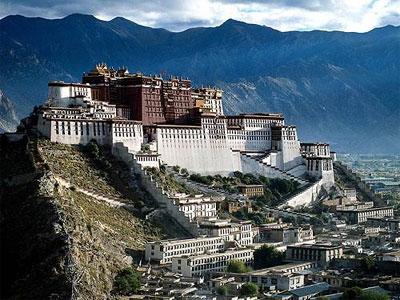 |
Home | About Us | Contact Us | Email | Reservation |
 |
    |
Potala Palace
 This architectural wonder is Lhasa' cardinal landmark. It can be seen from
all directions for miles around. Potala was set up in the seventh century
AD during the reign of King Songtsen Gampo. It's located on the Red Hill,
covers an area of 41 hectares.
At an
elevation of more than 3,700m, the Potala occupies an area of more than
360,000m. Its 13-story main portion rises 117m. The whole complex,
consisting of halls, stupa-tomb halls (where the relics of the supreme
lamas are preserved), shrines, prayer rooms, monks' dormitories and
courtyards, is recognized as the world's highest and largest castle
palace. (Please
be informed that there is a limitation of the incoming tourists
visiting Potala Palace everyday so as to protect the palace. Since the
palace is made of clay and wood, it could becomes very fragile and may
collapse if too many tourists enter the palace at the same time. As such
to visit Potala Palace, now very limited no. of tourists are allowed every
hour and the maximum time inside the palace has also been limited to just
one hour. Due to this, your sightseeing program may vary from morning to
afternoon or from one day to another as per the entry ticket availability
at Potala palace as such kindly be flexible.)
This architectural wonder is Lhasa' cardinal landmark. It can be seen from
all directions for miles around. Potala was set up in the seventh century
AD during the reign of King Songtsen Gampo. It's located on the Red Hill,
covers an area of 41 hectares.
At an
elevation of more than 3,700m, the Potala occupies an area of more than
360,000m. Its 13-story main portion rises 117m. The whole complex,
consisting of halls, stupa-tomb halls (where the relics of the supreme
lamas are preserved), shrines, prayer rooms, monks' dormitories and
courtyards, is recognized as the world's highest and largest castle
palace. (Please
be informed that there is a limitation of the incoming tourists
visiting Potala Palace everyday so as to protect the palace. Since the
palace is made of clay and wood, it could becomes very fragile and may
collapse if too many tourists enter the palace at the same time. As such
to visit Potala Palace, now very limited no. of tourists are allowed every
hour and the maximum time inside the palace has also been limited to just
one hour. Due to this, your sightseeing program may vary from morning to
afternoon or from one day to another as per the entry ticket availability
at Potala palace as such kindly be flexible.)
The name of the large sacred Buddhist building complex is a derivation from Samskrit Potalaka which is the mythical mountain abode of Avalokitesvara, one of the Bodhisattvas (Buddhist saints). In this connection Lhasa is popularly referred to as Second Mount Potalaka.
At an elevation of more than 3,700m, the Potala occupies an area of more than 360,000m. Its 13-story main portion rises 117m. The whole complex, consisting of halls, stupa-tomb halls (where the relics of the supreme lamas are preserved), shrines, prayer rooms, monks' dormitories and courtyards, is recognized as the world's highest and largest castle palace.
Built against the terraced slope of the hill, the structures combine to from a huge sky-scraping mass, reminscent of the divine realm above the mortal world. The granite walls elaborately decorated with soft white thatch, the golden roofs decorated with big gilded bottles, the splendid curtains and banners, join to form a unique structural wonder bearing the striking colors red, white and yellow characteristic of Tibetan architectural art, making the Potala an eminent example of a constructive technology traditionally Tibetan and Chinese.
As the winter residence of the successive Dalai Lamas, the Potala formerly served as the center of local Tebetan theocratic rule, hosting the major religious and political ceremonies since the reign of Dalai Lama V (1917-1682), at the same time housing the relics of those spiritual leaders.
The earliest project for the Potala started in A. D. 631 under Tibetan King Srang00brtsan-sgam-po (617?-650), which included 999 royal rooms plus a meditation chamber. That building was eventually destroyed by thunderbolts and wars.
Dalai Lama V, in his effort to consolidate his theocracy, entrusted in
1645 Bsod-glan-rab-den, his minister, with the rebuilding of the portion
known as the White Palace of the Potala and also the enclosures, towers
and turrets. When the project was completed, the patriarch moved his government
to the new building from Bras-spungs Monastery.
Later in 1690 Prime Minister Bsam-rgya-mtsho enlarged the Red Palace as
a part of his project to build Dalai Lama V's stupa-tomb. The extension
was eompleted in 1693, which was to be followed by new projects sponsored
by later Dalai Lamas, including 5 golden roofs and a number of accessory
structures.
Send Online Query
| Home | About Us | Contact Us | Email | Reservation |
| Site Designsed & Promoted by Tour of Tibet.com |